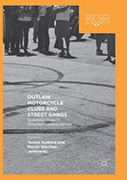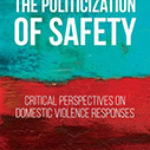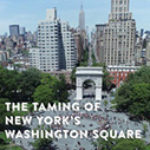Outlaw Motorcycle Clubs And Street Gangs: Scheming Legality, Resisting Criminalization

Authors: Tereza Kuldova and Martin Sanchez-Jankowski
Publisher: Cham, SWIT: Palgrave Macmillan, 2018. 234p.
Reviewer: James C. Howell | September 2019
This book provides valuable insights into Outlaw Motorcycle Clubs (OMCs)—also called Outlaw Biker Clubs. It is the product of a 2016 conference held at the University of Oslo, titled “Scheming Legality, Resisting Criminalization: How do Outlaw Groups Integrate into Society?” Each chapter evolved from a paper presented at that conference.
Although OMCs are by no means a new social phenomenon, observers continue to find it difficult to distinguish various outlaw groups from street gangs. The forerunners of the European OMCs, the first United States’ OMC (the Hells Angels) formed in the 1940s, and a large rumble involving the Hells Angels occurred in Hollister and Riverside, California in 1947. The Riverside police chief blamed this event on visiting “outlaws,” and thereafter this moniker was routinely applied to individuals connected with most criminally involved motorcycle clubs. The rumble in Hollister was immortalized by film director Stanley Kramer in the classic movie The Wild One, released in 1953. Shortly thereafter, the American Motorcycle Association released a statement proclaiming that the participants in the disorder were unrepresentative of the 99 percent of all motorcyclists who were law-abiding and presented no threat to society. By inference, it was the 1 percent on the lunatic fringe that fomented the violence in the alleged takeover of Hollister. Street clubs such as the Hell’s Angels very quickly appropriated the term ‘1 percenter’ as a badge of honor [and] it continues to provide a mechanism of boundary establishment between the ‘bikerism’ subculture and the wider society. The 1 percent culture rejects mainstream norms, maintaining an alternative social frame that revolves around a cluster of activities specific to the biker subculture. These activities include:
- the acquisition and maintenance of Harley-Davidson V -Twin motorcycles;
- organized ‘runs’, or large-scale excursions involving the members of the club or club chapter;
- activities necessary to acquire and maintain dominance within a particular geographic area.
- the maintenance of a clubhouse; and
- the organization of the club into a hierarchical, militarized structure, based on a club ‘constitution’, which establishes a code of conduct and sets the normative expectations agreed upon by the group.
In sum, motorcycle gangs [in the United States] have evolved over the past 67 years from bar room brawlers to sophisticated criminals. These gangs have adopted the public posture that they are nothing more than motorcycle riders who happen to belong to a club. The second part of their subterfuge lies with their claim that the criminal activities of individual members are not directed by the gang. Some OMC gangs claim their violent reputation is due to individual members’ prior criminal activities. In direct contradiction, this Kuldova and Sanchez-Jankowski volume demonstrates OMCs’ involvement in a variety of criminal activities, including drug use, possession of illegal narcotics, stabbings, assaults on police officers, and weapons charges.
Well documented in this book, the OMCs that were birthed in the United States have been reported in several other regions of the world. Guertjens and colleagues’ excellent chapter in this volume (“From Bikers to Gangsters”) covers Outlaw Biker Clubs in Germany, the Netherlands, and Belgium. Theirs is the most fully documented account of the duplication of American OMC’s traditions. From the 1960s onwards, Guertjens and colleagues contend that these clubs “started to expand their sphere of influence internationally, first to Australia and Europe, and later, in South America, Asia, and Africa” (p. 95). However, the Danish outlaw groups are not new. The Hells Angels MC (HAMC) and Bandidos MC (BMC) clubs opened chapters in Denmark in 1980 and 1993, respectively. Nevertheless, it is difficult to understand how Outlaw Motorcycle Clubs—comprised of outlaws and fluctuating memberships who are preoccupied with riding, and occasionally fighting, and consuming drugs—could effectively spread their influence from afar, across different countries and continents. It seems more realistic to assume that OMC culture migrated via internet-based news accounts and social media — copycatting, that is.
To summarize, this volume advises that Outlaw Motorcycle Clubs bear close watch wherever they may be found. Most important, these gang forms are currently present on three continents. Second, the OMCs are now involved in similar violent crimes to those in which more common street gangs participate. And third, the next big gang rumble could well occur anywhere these OMCs currently operate.
James C. Howell, Senior Research Associate, National Gang Center


